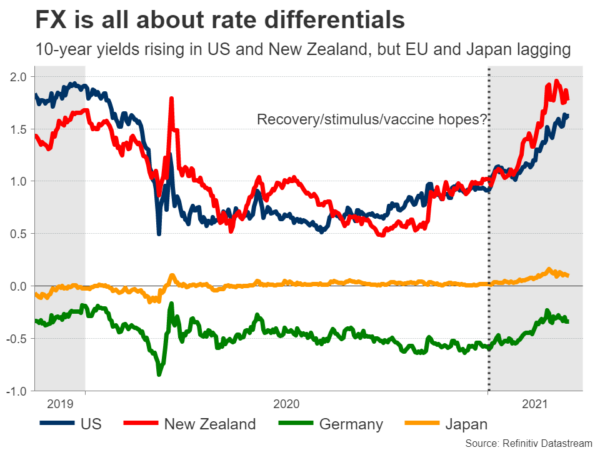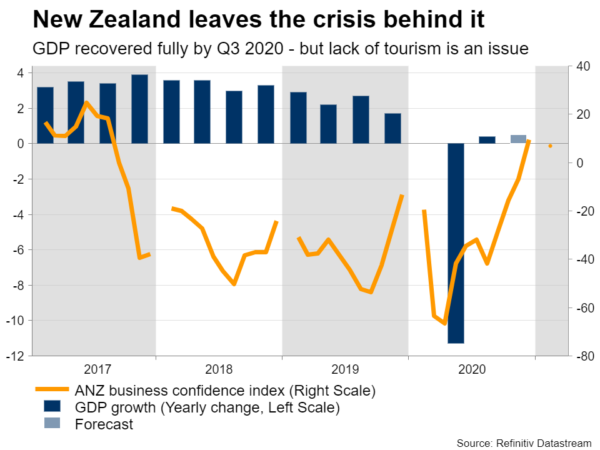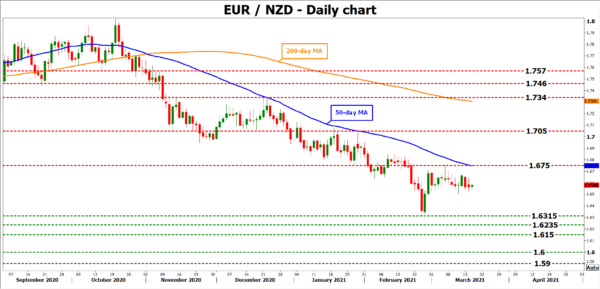Economic growth figures for Q4 out of New Zealand will hit the markets at 21:45 GMT Wednesday. Forecasts suggest that the economy has recovered all its losses from the crisis, even though the struggling tourism industry likely held back growth this quarter. As for the kiwi, the overall picture remains positive, particularly against the euro and the yen.
Complete recovery
New Zealand was essentially the first nation to defeat the virus, without even vaccinating anyone. An early and tight lockdown resulted in zero cases on the island since last summer, and the government kept the nation’s borders closed to ensure the situation stays that way. Meanwhile, it enacted powerful relief programs to support businesses and jobs.
As a result, the economy has made a stunning recovery. GDP numbers suggest that economic activity was already back at pre-pandemic levels in the third quarter of 2020, employment and inflation have been stronger than expected, and the housing market is booming. Additionally, commodity prices have surged, spelling good news for exporters.
Of course, it’s not all rosy. Some covid cases have been reported lately, resulting in brief lockdowns in some of the major cities. Similarly, vaccinations have just started, so New Zealand is way behind in the global immunization race.
Still, the overall picture for the economy and public health is much better than most other regions, Europe in particular.
Lack of tourism restrains growth
Turning to the upcoming dataset, economic growth likely cooled towards the end of the year. GDP is expected to have risen just 0.1% in Q4 from the previous quarter, which would bring growth to 0.5% from a year ago.
The relatively soft performance likely comes down to the tourism sector. The hospitality sector is struggling because the nation’s borders are still shut, and the December quarter is typically the strongest period for tourism given the warm weather in New Zealand. 
Having said that, GDP being higher from a year ago is still an incredible achievement, considering the global crisis.
What’s the outlook for the kiwi?
The knee-jerk reaction in the kiwi will depend on any surprises in the GDP numbers, though the overall picture for the currency seems positive. The domestic economy is solid, commodity prices are elevated, and some benefits from the enormous US stimulus packages are likely to spill over into exporting economies like New Zealand. Markets are now pricing in a 50% probability for an RBNZ rate hike by this time next year.
The catch is that the outlook for the US dollar is also bright. America has accelerated its vaccination program and the economy is about to enjoy a stimulus-fuelled boom. The Fed may be among the first central banks to raise rates again.
In contrast, most of the Eurozone is still locked down, the vaccination rollout has been a mess, and the ECB has made it clear that it won’t allow European yields to rise much. It will probably be among the last to raise rates this cycle, if it does at all. The Bank of Japan is a similar story.
As such, euro/kiwi and kiwi/yen may be better proxies than dollar/kiwi for any future gains in the New Zealand dollar.
Taking a technical look at euro/kiwi, further declines could encounter initial support near the recent two-year low of 1.6315. A downside break would turn the focus towards the 1.6235 zone, marked by the peak of May 2017.
On the upside, the first target for buyers would be the 1.6750 area, which also encompasses the 50-day moving average. If violated, resistance may then be found around the 1.7050 region.















